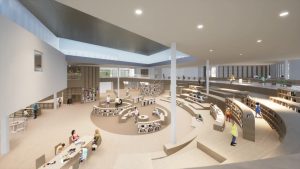 Okuma is a municipality with a population of around 10,000, located in the area facing the Pacific Ocean known as ‘Hamadori’ in Fukushima Prefecture. However, the situation is a little different from that of an ordinary town.
Okuma is a municipality with a population of around 10,000, located in the area facing the Pacific Ocean known as ‘Hamadori’ in Fukushima Prefecture. However, the situation is a little different from that of an ordinary town.
At 2:46 pm on 11 March 2011. Okuma Town in Fukushima Prefecture was hit by a tremor of intensity 6 on the Japanese scale. The tsunami inundated approximately 2 sq km of the coastal area. Twelve townspeople were killed. The TEPCO Fukushima Daiichi nuclear power plant is located in Okuma. The Fukushima Daiichi Nuclear Power Plant, located on the coast, was also hit by a tsunami of over 10 metres, resulting in the loss of power and the release of radioactive substances from Units 1-4.
On 12 March, an evacuation order was issued for the entire town of Okuma. The evacuation, which many townspeople said was only meant to last a couple of days, is still ongoing in most of the town as of December 2022, more than 10 years later. In some areas of the town where radiation levels were low, the evacuation order was lifted in April 2019 and a new town hall building was built there.
At the end of March 2011, soon after the ‘town-wide evacuation’, Okuma Town decided to evacuate to Aizu Wakamatsu City, Fukushima Prefecture, on the assumption that education would resume in the new school year. In April of the same year, 135 kindergarten, 357 primary school and 216 junior high school students, more than the town had anticipated, were sent to Okuma’s kindergartens and schools, which had been set up in abandoned schools and school buildings in Aizuwakamatsu.
As the evacuation became more protracted and the foundations of life were established in the evacuation sites, more and more children were transferred to schools in the municipalities where they had been evacuated. Each family made the necessary choice at the time, whether to adapt to the evacuation site or to continue attending school in Okuma.
The ‘town-wide evacuation’ lasted for more than eight years, and the town hall resumed operations back in the town in May 2019. Since then, public housing has been built, commercial facilities have been constructed, welfare facilities have been completed, and community and accommodation facilities opened in September 2021. We are right in the middle of a town being built from scratch.
The town’s schools are finally returning to the area.
Since the disaster, schools have had to cope with a rapidly declining birth rate. Sports days were held jointly at elementary and junior high schools, and junior high school students went to elementary schools to present their studies. Teachers have discovered the advantages of the education that the ‘Dream Forest’ aims for, which does not draw lines between schools or grades while worrying about it in the field with the children.
The small number of students has been allowed to find out what they can do “together” with “individual optimisation” in the classroom, and learning that takes into account the understanding and interests of individual children, rather than uniform teaching, has progressed. The introduction of IT equipment has also been relatively smooth as the number of students is small. In schools, tablet PC terminals have already been distributed to each pupil from the age of eight, and AI teaching materials have been introduced since 2020.
Instead of defining pupils as ‘children who will support the reconstruction of the town’, we consider them as people who are happy just to be there. It is precisely because the town is like this that the school can be the centre of the local community, and we want them to meet and interact with all kinds of people, and if they are interested, to get involved in town planning.
We want to realise, one by one, the kind of learning that is possible only in Okuma, a town faced with a small number of students, and where town planning is being promoted from scratch.
“Mixed” is one of the keywords. The photo shows the completed learning centre. [INSERT PHOTO]
There are classrooms, but the walls can be moved and the children’s school and compulsory education school are not specifically separated. The space extends and expands around the library space.
Even though the schools are systematically divided into two separate institutions, with grades 1-9, everyone is able to share the same space as necessary. The learning centre aims to make such an environment where a baby can lie down next to a 15-year-old reading a book the norm.
Text kindly provided by Okuma Town Municipality and translated from the original Japanese by JLGC.

